70 countries, 17000 people / 40 music albums / Quốc ca Của Festac / Le Théâtre National / $400 million / ₦117,933,081,231.72 in 2024 /
70 countries, 17000 people / 40 music albums / Quốc ca Của Festac / Le Théâtre National / $400 million / ₦117,933,081,231.72 in 2024 /
DID YOU KNOW? Festac drew in 70 countries and at least 17,000 people internationally.
Summary & Credits
(EN)
Tac is the initial release of a single style, bold weight, sans
serif typeface project that is inspired by the wordmark of one of
the most significant festivals in Africa's post-colonial history,
Festac '77. As an inspired revival, it expands upon the six
lowercase letters, single quotes and numeral 7 in the festival's
wordmark, resulting in a contemporary font with comprehensive
language support for all African languages that are commonly
written with the Latin writing system.
Tac is a typeface by
Afrotype.
Research notes are by
Ife Adegbie
and
Seyi Olusanya.
Special thanks to
Laura,
Mirko,
Thomas,
Dave,
Travis,
Lizy,
and
Ksenya
(FR)
Tac est la première version d'un projet de police de style unique,
gras et sans empattement, inspiré du mot-symbole de l'un des
festivals les plus importants de l'histoire postcoloniale de
l'Afrique, Festac '77. En tant que renaissance inspirée, il
développe les six lettres minuscules, les guillemets simples et le
chiffre 7 du mot-symbole du festival, résultant en une police
contemporaine avec un support linguistique complet pour toutes les
langues africaines couramment écrites avec le système d'écriture
latin.
Tac est une police
d'Afrotype.
Les notes de recherche sont rédigées par
Ife Adegbie
et
Seyi Olusanya.
Un merci spécial à
Laura,
Mirko,
Thomas,
Dave,
Travis,
Lizy,
and
Ksenya
Tac
The first iteration of the World Black and African Festival of Arts and Culture was hosted in Dakar 1966 called FESMAN (World Festival of Black Arts)
Tac
Festac '77, also known as the Second World Black and African Festival of Arts and Culture (the first was in Dakar, 1966), was a major international festival held in Lagos, Nigeria, from 15 January 1977 to 12 February 1977. The month-long event celebrated African culture and showcased to the world African music, fine art, literature, drama, dance and religion.
Tac
FESTAC marked the ending of what was called ‘festival decade’; celebrations of black and African consciousness in different scales. Other include All Africans People Conference Ghana 1958, AMSAC 1961, Lagos , Pan-African Cultural Festival 'Algiers 69 or PANAF ’69’, ‘Soul to Soul Concert’ 1971, Caribbean Festival of Culture and Arts ‘CARIFESTA 1972’, Zaire 1974. The third festac, Ethopia 1981 never happened.
Tac ・160px
Noir
Tac ・80px
Festival
Tac ・48px
The first iteration of the World Black and African Festival of Arts and Culture was hosted in Dakar 1966 called FESMAN (World Festival of Black Arts)
Afro-Latin Support
(EN) Tac supports the Google Latin Core, Plus, Vietnamese and African character sets, including but not limited to Swahili, Zulu, Hausa, Yoruba, and Shona.
(FR) Tac prend en charge les jeux de caractères Google Latin Core, Plus, vietnamiens et africains, y compris, mais sans s'y limiter, le swahili, le zoulou, le haoussa, le yoruba et le shona.
Try Tac in an Afro-Latin language
Sa'an nan Abu Sufyan ya isa
a
Opentype features
(EN) Tac supports several opentype features like stylistic sets, ligatures and stacked fractions
(FR) Tac prend en charge plusieurs fonctionnalités opentype telles que les ensembles stylistiques, les ligatures et les fractions empilées
Language support
(EN) Tac supports well over 900 languages, with a focus on African languages, encompassing over 570 of them.
(FR) Tac prend en charge plus de 900 langues, en mettant l'accent sur les langues africaines, englobant plus de 570 d'entre elles.
Abidji, Abron, Adangme, Adara, Adele, Afar, Afrikaans, Agatu, Aghem, Agwagwune, Ahanta, Aja, Akan, Alago, Anii, Anufo, Anyin, Arabic (Chadian Spoken), Ashe, Asu, Avatime, Avokaya, Awak, Ayizo Gbe, Baatonum, Bacama, Bafia, Baga Sitemu, Baka, Bali, Bambara, Bamun (Latin), Bana, Banda (West Central), Bandi, Bangwinji, Baoulé, Bapuku, Bari, Basa, Basaa, Bassa, Bassari, Bedawiyet, Bedjond, Bekwarra, Belanda Viri (Latin), Bemba, Bena, Bench, Beng, Benga, Berom, Bete-Bendi, Bété (Guiberoua), Bhele, Bilen, Bimoba, Bini, Birifor (Southern), Bisã, Bissa, Boko, Bokobaru, Buamu, Budu, Bulu, Bura-Pabir, Burak, Bushi, C’Lela, Cahungwarya, Cakfem-Mushere, Central Atlas Tamazight, Central-Eastern Niger Fulfulde, Cerma, Chiduruma, Chiga, Chokwe, Chumburung, Cishingini, Comorian (Latin), Comorian (Ngazidja), Crioulo (Upper Guinea), Cwi Bwamu (Latin), Daba, Dadiya, Dagaare (Southern), Dagbani, Dangaléat, Dawro, Dazaga, Deg, Delo, Dendi, Denya, Dghwede, Dida (Yocoboué), Didinga, Dikaka, Dinka, Dinka (Northeastern), Ditammari, Dogon (Toro So), Doyayo, Duala, Duya, Dyula, Dza, Ebira, Ede Cabe, Ede Ica, Ede Idaca, Ede Ije, Ejagham, Elip, Embu, Engenni, English, Etkywan, Etulo, Ewe, Ewondo, Ezaa, Fe’fe’, Fon, Foodo, French, Fulah, Fulfulde (Adamawa), Fulfulde (Borgu), Fulfulde (Western Niger), Fuliiru, Fur, Ga, Gamo, Ganda, Gbari, Gbaya (Sudan), Gbaya-Mbodomo, Gbe (Tofin), Gbe (Waci), Gbe (Xwela), Gen, German, Gikyode, Godié, Goemai, Gofa, Gokana, Gonja, Gor, Gourmanchéma, Gude, Gumuz, Gun, Gungu, Gusii, Gwak, Gyele, Hanga, Hausa, Hdi, Hyam, Ibani, Ibibio, Igbo, Igede, Igo, Ijo (Southeast), Ik, Ika, Ikposo, Ikwere, Ikwo, Iten, Ivbie North-Okpela-Arhe, Izere, Izii, Jibu, Jola-Fonyi, Jola-Kasa, Jukun Takum, Jur Modo, Kabalai, Kabiyé, Kabuverdianu, Kabyle, Kalenjin, Kamba, Kamuku, Kamwe, Kanuri, Kanuri (Central), Kanuri (Manga), Kaonde, Karaboro (Eastern), Karang, Karekare, Kasem, Kenga, Kenyang, Kibaku, Kikuyu, Kimbundu, Kimré, Kinyarwanda, Kirike, Kissi (Northern), Kituba, Koma, Kombe, Kongo, Konjo, Konkomba, Koonzime, Kouya, Koyra Chiini, Koyraboro Senni, Kpelle (Guinea), Krache, Krio, Krumen (Plapo), Krumen (Tepo), Kuanyama, Kukele, Kunama, Kuo, Kuria, Kusaal, Kutep, Kutu, Kwanja, Kwasio, Kwere, Lama (Togo), Lamang, Lamnso', Langi, Lele, Lendu, Lese, Ligbi, Limba (West-Central), Limbum, Lingala, Lobala, Lobi, Logo, Lokaa, Loko, Longuda, Lozi, Luba-Katanga, Luba-Lulua, Lugbara, Luguru, Lukpa, Lunda, Luo, Luvale, Luwo, Luyia, Lyélé, Maasina Fulfulde, Machame, Makaa, Makhuwa, Makhuwa-Meetto, Makonde, Malagasy, Malay (Latin), Mamara Senoufo, Mambila (Cameroon), Mambila (Nigeria), Mampruli, Mandingo, Mandjak, Mangbetu, Maninka (Sankaran), Maninkakan (Eastern), Masai, Mauritian Creole, Mbe, Mbelime, Mbembe (Cross River), Mbo, Mbuko, Mbula-Bwazza, Me’en, Mende, Ménik, Merey, Meru, Meta’, Mina, Miyobe, Mmaala, Moba, Mokole, Morokodo, Mossi, Mumuye, Mundang, Mundani, Mündü, Muyang, Mwaghavul, Mwan, Mwani, Nafaanra, Nama, Nara, Nateni, Nawdm, Nawuri, Ndamba, Ndogo, Ndonga, Ngambay, Ngangam, Ngas, Ngbaka, Ngbandi (Northern), Ngiemboon, Ngindo, Ngiti, Ngomba, Ngulu, Nigerian Fulfulde, Nigerian Pidgin, Ninzo, Nkonya, Nomaande, Noone, North Ndebele, Northern Dagara, Northern Sotho, Ntcham, Nuer, Nugunu, Nuni (Northern), Nupe-Nupe-Tako, Nyabwa, Nyamwezi, Nyanja, Nyankole, Nyemba, Nzima, Obolo, Ogbah, Okiek, Oromo, Otuho, Paasaal, Pangu, Parkwa, Pero, Pogolo, Pökoot, Portuguese, Pulaar, Pular, Pyam, Rendille, Reshe, Réunion Creole French, Rigwe, Rombo, Ron, Rundi, Rwa, Saafi-Saafi, Samburu, Sango, Sangu, Sãotomense, Saxwe Gbe, Sekpele, Selee, Sena, Sénoufo (Djimini), Sénoufo (Supyire), Serer, Seselwa Creole French, Shambala, Sheko, Shilluk, Shona, Sisaala (Tumulung), Sissala, Siwu, Soga, Sokoro, Somali, Soninke, South Ndebele, Southern Nuni, Southern Sotho, Spanish, Suba, Sudanese Arabic, Sukuma, Suri (Tirmaga-Chai), Susu, Swahili, Swati, Tachelhit (Latin), Taita, Takwane, Tal, Talinga-Bwisi, Tamasheq (Latin), Tampulma, Tangale, Tarok, Tasawaq, Tedaga, Téén, Tem, Tera, Teso, Tiéyaxo Bozo, Tikar, Timne, Tiv, Toma, Tonga, Toura, Toussian (Southern), Tsikimba, Tsishingini, Tsonga, Tsuvadi, Tswana, Tula, Tumbuka, Tunen, Tuwuli, Umbundu, ut-Hun, ut-Ma’in, Vagla, Vai (Latin), Venda, Vengo, Vunjo, Vute, Waama, Waja, Wan, Wandala, Warji, Wè Northern, Wolaytta, Wolof, Xhosa, Yala, Yalunka, Yamba, Yambeta, Yangben, Yao, Yaouré, Yasa, Yom, Yoruba, Zande, Zarma, Zayse, Zigula, Zulgo-Gemzek, and Zulu.
Achuar-Shiwiar, Aguaruna, Aleut, Amahuaca, Amarakaeri, Arabela, Arapaho, Asháninka, Ashéninka Perené, Ashéninka (Pichis), Awa-Cuaiquer, Aymara, Bora, Candoshi-Shapra, Caquinte, Cashibo-Cacataibo, Cashinahua, Central Alaskan Yupik, Central Mazahua, Chachi, Chayahuita, Chickasaw, Chimborazo Highland Quichua, Chinantec (Chiltepec), Chinantec (Ojitlán), Cofán (Latin), Colorado, Crioulo (Upper Guinea), Danish, Delaware, Dutch, English, Epena (Latin), Ese Ejja, Filipino, French, Garifuna, German, Guadeloupean Creole French (Latin, Martinique), Guarani, Guarayu, Guianese Creole French, Gwichʼin, Haitian Creole, Hawaiian, Hindustani (Sarnami), Hopi, Huastec (San Luís Potosí), Huitoto (Murui), Innu, Italian, Jamaican Creole English, Kaingang, Kalaallisut, Kaqchikel (Central), Kituba, Kulango (Bouna), Kʼicheʼ, Lakota, Lushootseed, Mam, Mapuche, Matsés (Latin, Peru), Mazatec (Ixcatlán), Mi'kmaq, Mískito, Mixe (Totontepec), Mixtec (Metlatónoc), Mohawk, Moro, Muscogee, Nahuatl (Central), Navajo, Nomatsiguenga, Otomi (Mezquital), Páez, Papiamento, Pipil, Portuguese, Purepecha, Q'eqchi', Quechua, Quechua (Ambo-Pasco), Quechua (Arequipa-La Unión), Quechua (Ayacucho), Quechua (Cajamarca), Quechua (Cusco), Quechua (Huamalíes-Dos de Mayo Huánuco), Quechua (Huaylas Ancash), Quechua (Margos-Yarowilca-Lauricocha), Quechua (North Junín), Quechua (Northern Conchucos Ancash), Quechua (South Bolivian), Quechua (Unified Quichua, old Hispanic orthography), Romany, Saint Lucian Creole French (Latin), Secoya, Seri, Sharanahua, Shipibo-Conibo, Shuar (Latin, Ecuador), Siona, Spanish, Sranan Tongo, Straits Salish (Latin), Tenango Otomi (Latin), Ticuna, Toba, Tojolabal, Totonac (Papantla), Tzeltal (Oxchuc), Tzotzil (Chamula), Uduk, Urarina, Vietnamese, Waorani, Wayuu, Welsh, Xavánte, Yagua, Yaneshaʼ, Yanomamö, Yucateco, Záparo, Zapotec, Zapotec (Güilá), Zapotec (Miahuatlán), and Zuni.
Achinese, Albanian, Amis, Ao Naga, Assyrian Neo-Aramaic (Latin), Azerbaijani, Balinese, Batak Toba, Betawi, Bikol, Bodo (Latin), Brahui (Latin), Buginese, Cebuano, Central Dusun, Chavacano (Latin, Philippines), Chin (Falam), Chin (Haka), Chin (Matu), Cuyonon (Latin), Dimli, Drung, English, Filipino, French, Galo (Latin), Gelao (Klau), German, Hani, Hiligaynon, Hmong Njua, Hmong (Northern Qiandong), Hmong (Southern Qiandong), Hungarian, Iloko, Indonesian, Jarai (Latin), Javanese, Kazakh (Latin), Khasi, Kirmanjki, Kurdish (Latin), Ladino (Latin), Madurese, Malay, Maranao (Latin), Minangkabau, Mizo (Latin), Musi (Latin), Muslim Tat (Latin), Oroqen, Paite Chin (Latin), Pampanga, Polish, Portuguese, Rejang, Rinconada Bikol, Rohingya (Latin), Romani (Balkan), Romanian, Romany, Salar, Sasak, Serbian (Latin), Southern Tujia, Spanish, Sundanese, Tajik (Latin), Talysh (Latin), Tedim Chin, Tetum, Tetun Dili, Tsakhur (Latin), Turkish, Turkmen (Latin), Uab Meto, Uyghur (Latin), Uzbek, Vietnamese, Wancho Naga (Latin), Waray, West Albay Bikol, and Zhuang.
Albanian, Aragonese, Aromanian, Arpitan, Asturian, Bashkir (Latin), Basque, Belarusian (Latin), Bosnian, Breton, Catalan, Colognian, Cornish, Corsican, Crimean Turkish, Crioulo (Upper Guinea), Croatian, Czech, Danish, Dutch, English, Esperanto, Estonian, Extremaduran, Faroese, Finnish, Finnish (Kven), French, Friulian, Gagauz, Galician, German, Gheg Albanian, Hungarian, Icelandic, Inari Sami, Indonesian, Interlingua, Irish, Italian, Jèrriais (Latin), Kalaallisut, Karelian, Kashubian, Ladin, Latgalian, Latin, Latvian, Ligurian, Lithuanian, Livonian, Lombard, Low German, Lower Sorbian, Lule Sami, Luxembourgish, Maltese, Manx, Middle High German, Mirandese, Neapolitan, Northern Frisian, Norwegian Bokmål, Norwegian Nynorsk, Occitan, Old English, Old French, Old High German, Old Irish, Old Norse (Latin, Sweden), Old Provençal, Old Welsh (Latin), Oroqen, Picard, Piedmontese, Polish, Portuguese, Romagnol, Romani (Balkan), Romanian, Romansh, Romany, Sardinian, Sassarese Sardinian, Saterland Frisian, Scottish Gaelic, Serbian (Latin), Sicilian, Silesian, Slovak, Slovenian, Southern Sami, Spanish, Swedish, Swiss German, Tatar (Latin), Turkish, Uncoded languages (Latin, World), Upper Sorbian, Venetian, Veps, Võro, Walloon, and Walser.
Bislama, Chamorro, Chin (Haka), Chuukese, Cook Islands Māori, English, Fijian, French, Gilbertese, Italian, Maori, Marshallese, Niuean, Palauan, Pijin, Pintupi-Luritja, Pohnpeian, Rapa (Latin), Samoan, Tahitian, Tiwi (Latin), Tok Pisin, Tokelau, Tongan, Tuvalu, Wallisian, Warlpiri, and Yapese.
Get Tac
(EN) You can download Tac for free on Google Fonts. For a more comprehensive version with stylistic sets and other OpenType features, you can download directly from this site.
(FR) Vous pouvez télécharger Tac gratuitement sur Google Fonts. Pour une version plus complète avec des ensembles stylistiques et d'autres fonctionnalités OpenType, vous pouvez la télécharger directement depuis ce site.



Research and Design Notes
(EN) Tac is a single-weight, bold san-serif inspired by the wordmark of one of the most important cultural events in Africa's post-colonial history, Festac '77. The revival expands upon the six lowercase letters, single quotes, and number 7 in the wordmark, resulting in a complete Google SSA character set of over 1100 glyphs.
(FR) Tac est un san-serif audacieux à un seul poids, inspiré du mot-symbole de l'un des événements culturels les plus importants de l'histoire postcoloniale de l'Afrique, le Festac '77. La renaissance s'étend sur les six lettres minuscules, les guillemets simples et le chiffre 7 du mot-symbole, ce qui donne lieu à un jeu de caractères Google SSA complet de plus de 1 100 glyphes.

The Second Edition of the Largest Black African Festival
The Second Edition of the Largest Black African Festival
(EN)
The second edition of the Festival of Black Arts and
Culture, FESTAC, was organised by the federal government of
Nigeria in collaboration with the United Nations
Educational, Scientific and Cultural Organization (UNESCO)
in early 1977. The festival was created to amplify black and
African culture globally, empower black and African artists
worldwide, and support cultural reconnection to Africa.
It was a very ambitious endeavour. More than 15,000
participants came from about 55 countries worldwide. Nigeria
could only afford this because of its newly found oil
wealth. The Nigerian naira significantly surpassed the US
dollar, trading at ₦1.00 for $1.60 in 1976, a year before
the event. The festival is estimated to cost about 400
million dollars, equivalent to about 1.85 billion today.
(FR)
La deuxième édition du Festival des arts et de la culture
noirs, FESTAC, a été organisée par le gouvernement fédéral
du Nigeria en collaboration avec l'Organisation des Nations
Unies pour l'éducation, la science et la culture (UNESCO) au
début de 1977. Le festival a été créé pour amplifier la
culture noire et africaine. la culture à l’échelle mondiale,
autonomiser les artistes noirs et africains du monde entier
et soutenir la reconnexion culturelle avec l’Afrique.
C'était une entreprise très ambitieuse. Plus de 15 000
participants sont venus d'environ 55 pays à travers le
monde. Le Nigeria ne pouvait se le permettre qu’en raison de
ses nouvelles richesses pétrolières. Le naira nigérian a
largement dépassé le dollar américain, s'échangeant à 1,00 ₦
pour 1,60 $ en 1976, un an avant l'événement. Le coût du
festival est estimé à environ 400 millions de dollars, soit
l'équivalent d'environ 1,85 milliard aujourd'hui.

Visual Identity
Visual Identity
(EN)
The official emblem of the festival was a replica of Benin's
royal ivory mask, crafted by Erhabor Emokpae. A
vectored version of this sculpture graces many communication
and marketing materials. Coupled with this emblem is the
wordmark “festac ‘77.”
Despite its ubiquity across communication materials, we know
little about the actual lettering/wordmark “festac ‘77”
design.
(FR)
L'emblème officiel du festival était une réplique du masque
royal en ivoire du Bénin, fabriquée par Erhabor.
Emokpae.
Une version vectorielle de cette sculpture orne de nombreux
supports de communication et de marketing. À cet emblème est
associé le mot-symbole «festac '77».
Malgré son omniprésence dans les supports de communication,
nous savons peu de choses sur le design réel du
lettrage/mot-symbole “festac ‘77”.


Construction and Components
Construction and Components
(EN) We began the design process by studying the lettering's construction and contrast model. We deduced that the contrast model is translational; the contrast amount is very high and is related to construction from a 180-degree broad brush. Three main shape elements to draw all forms. 180-degree broad brush straights (Fig 5), 180-degree broad brush curves(Fig 6), and then for horizontal strokes, 90 degrees (Fig 7). Most characters are no more than three elements/strokes (Fig 8)
(FR) Nous avons commencé le processus de conception en étudiant la construction du lettrage et le modèle de contraste. Nous en avons déduit que le modèle de contraste est translationnel ; le contraste est très élevé et est lié à la construction d'un pinceau large à 180 degrés. Trois éléments de forme principaux pour dessiner toutes les formes. Des lignes droites de pinceau larges à 180 degrés (Fig 5), des courbes de pinceau larges à 180 degrés (Fig 6), puis pour les traits horizontaux, 90 degrés (Fig 7). La plupart des caractères ne comportent pas plus de trois éléments/traits (Fig 8)
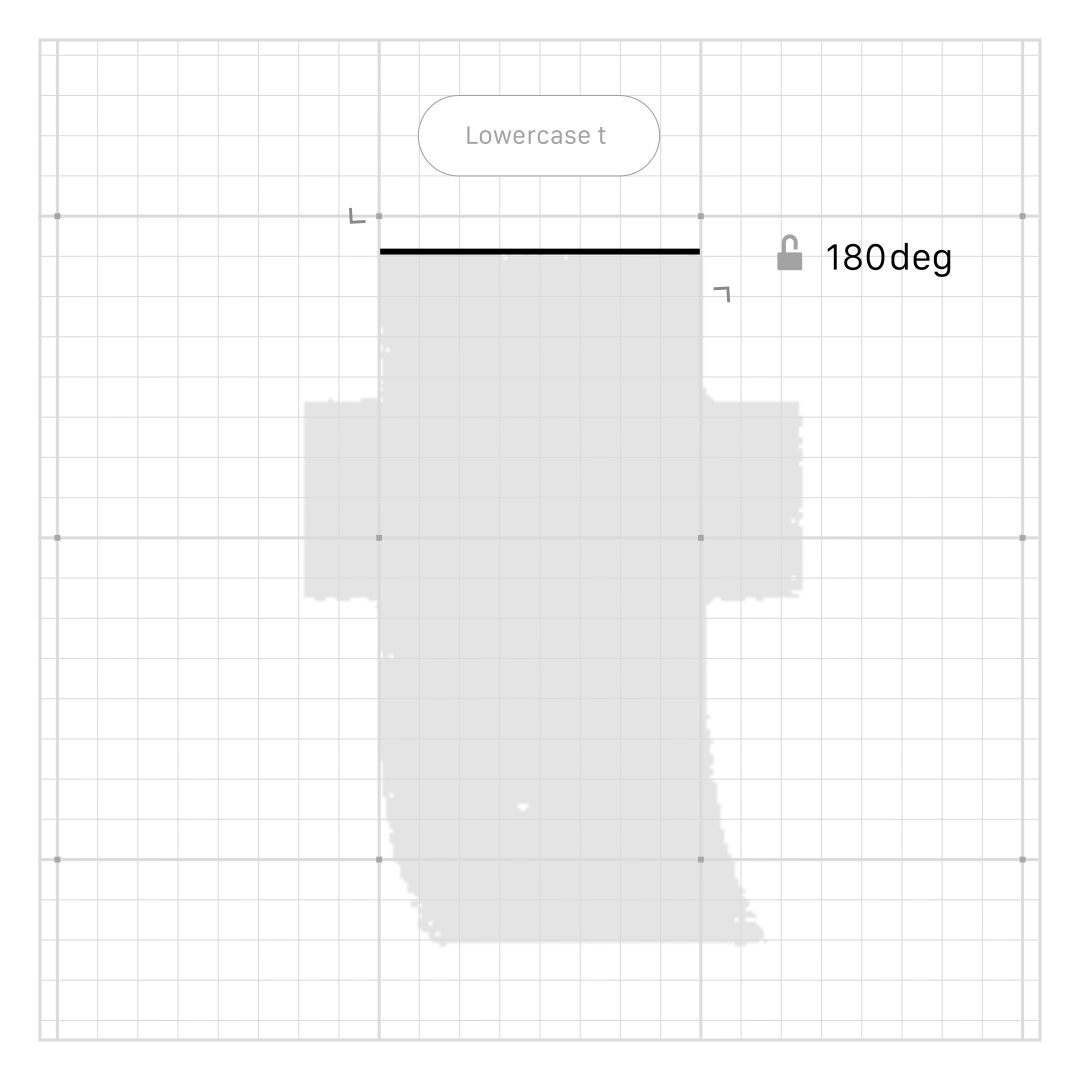
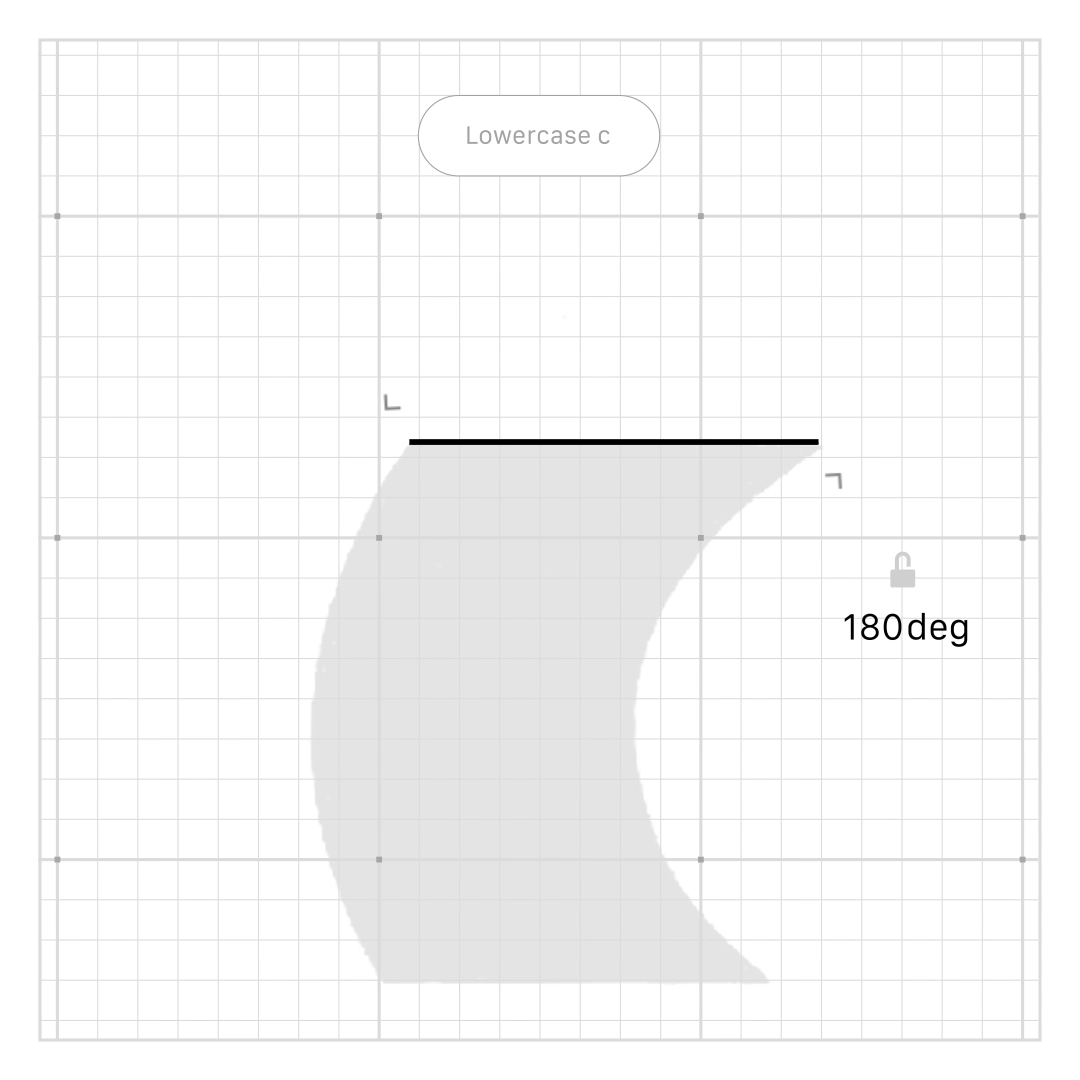
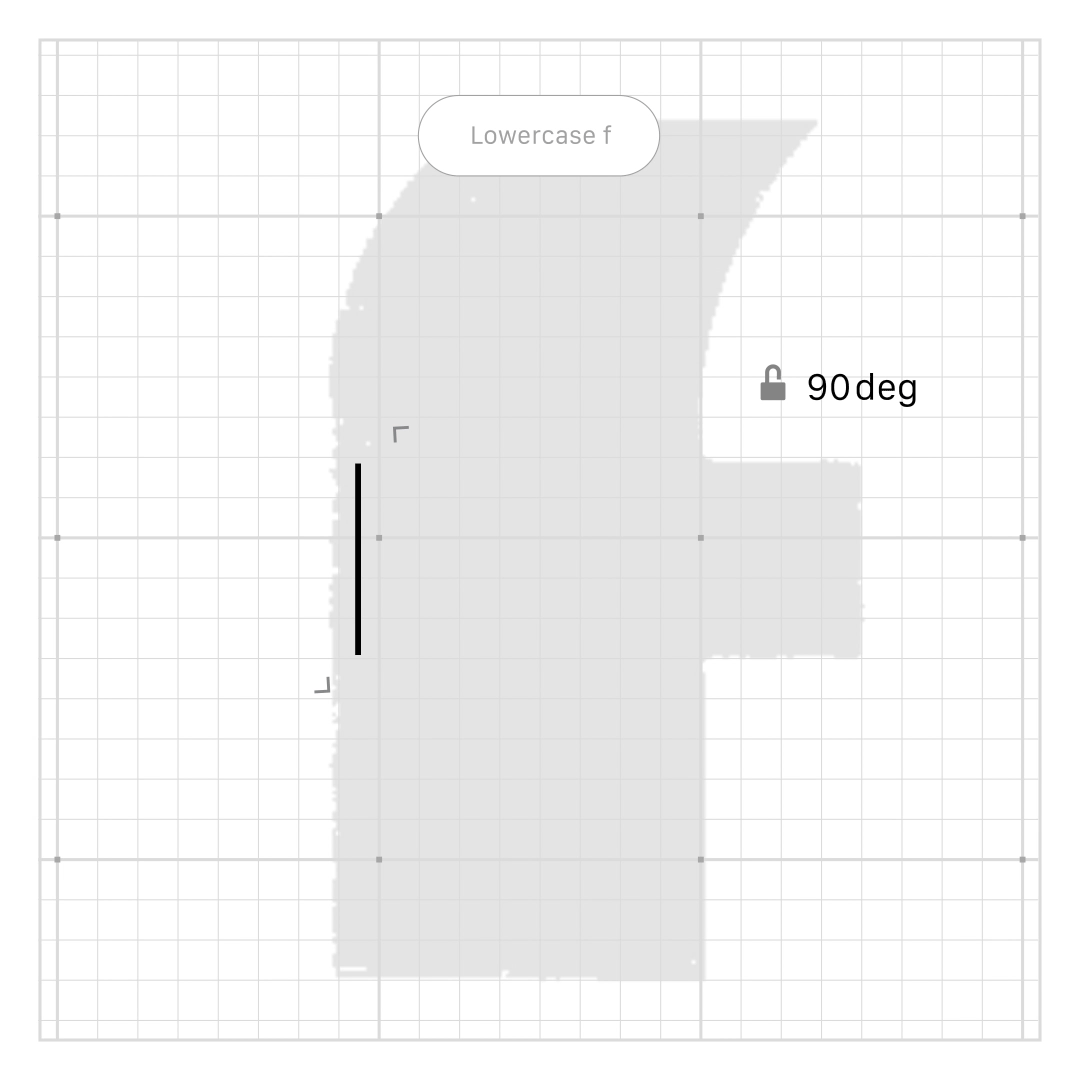

(EN) Contrast comes from curves meeting curves (Fig 9. a), curves meeting straights (Fig 10. t), and horizontals from the brush held at 90 degrees in “f” and “7” (Fig 11. 7).
(FR) Le contraste provient des courbes rencontrant des courbes (Fig 9. a), des courbes rencontrant des droites (Fig 10. t) et des horizontales du pinceau tenu à 90 degrés en “f” et “7” (Fig 11. 7).



Creating New Letterforms
Creating New Letterforms
(EN) We developed a recipe and then danced between modifying the established components in an iterative cycle of “transform” actions like reflection and mirroring. We also adjusted the points per glyph to fit the expected construction. We also increased the x-height of the lowercase letters and opened up the counters for better legibility. (Fig 12. a mirrored to e) (Fig 13. Adding straight stem to c to form d)
(FR) Nous avons développé une recette puis dansé entre la modification des composants établis dans un cycle itératif d'actions de “transformation” comme la réflexion et le miroir. Nous avons également ajusté les points par glyphe pour les adapter à la construction attendue. Nous avons également augmenté la hauteur x des lettres minuscules et ouvert les compteurs pour une meilleure lisibilité. ( Fig 12 . a en miroir avec e) (Fig 13. Ajout d'une tige droite à c pour former d)
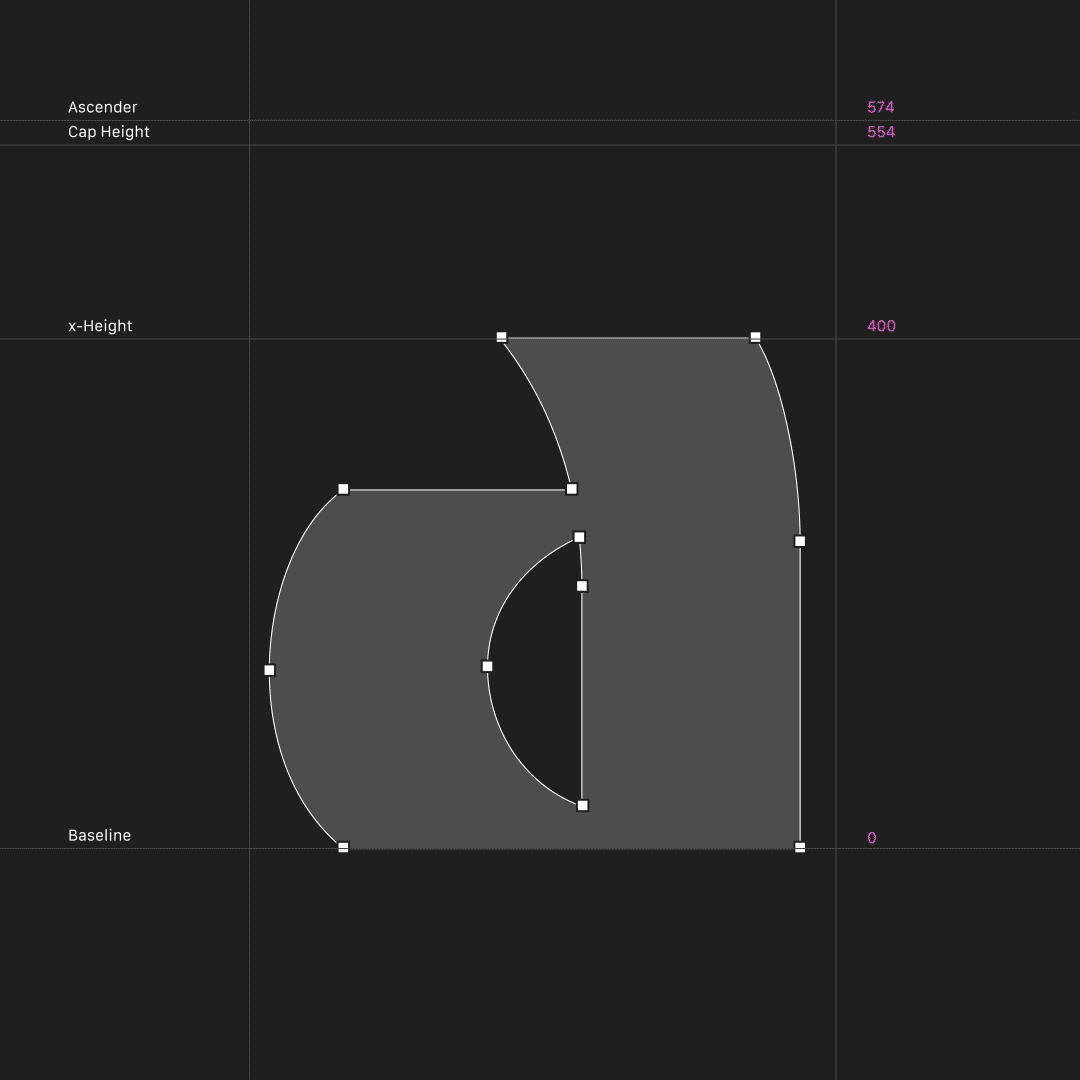
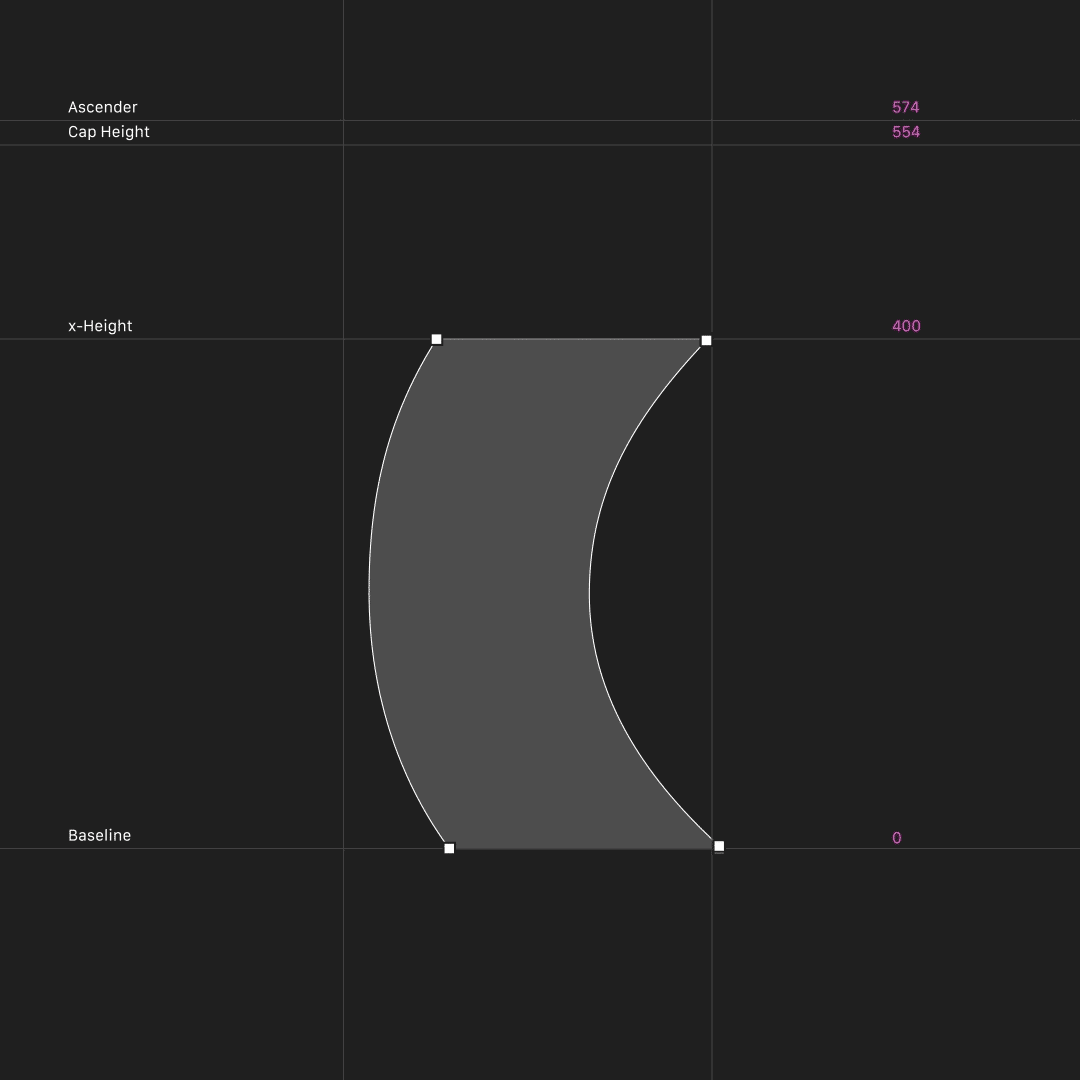
Full Set
Full Set
(EN) After several months of iteration, we developed a large set of letters, numbers, and punctuation based on an established process.
(FR) Après plusieurs mois d'itération, nous avons développé un large éventail de lettres, de chiffres et de signes de ponctuation sur la base d'un processus établi.
